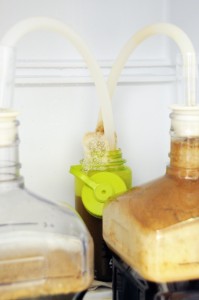One of the greatest things about homebrewing is that it enables you to dissect commercial beers and make your own attempts at brewing beers of a similar nature. Precise replication is rare, even when you’re working from a proven recipe, but the exercise in itself is enjoyable, and the beers typically turn out quite tasty.
Back in 2011, I was inspired to take a shot at cloning Firestone Walker’s Parabola, and posted a quickly cobbled together recipe on HomebrewTalk. Now, a couple years later I’ve finally gotten around to taking a shot at it.
The recipe below was put together while carefully tasting the commercial beer and reading through the information published on both bottles of Parabola and on Firestone Walker’s website. The information that is out there indicates a very complex malt bill; something that makes determining the precise percentages of each malt somewhat of a shot in the dark. That being said, I’ve based the recipe on typical uses of those grains and what I’ve been able to taste in the commercial beer. The actual brewday was quite uneventful, and the beer is happily fermenting away. My plan is to transfer it onto oak in secondary and to let it rest until next April, which happens to coincide with the annual commercial release of Parabola. Stay tuned for future posts reviewing the beer and indicating how close this recipe replicates the commercial beer.
Recipe:
Size: 2.74 gal
Efficiency: 60%
Attenuation: 73.0%
Original Gravity: 1.127 SG
Terminal Gravity: 1.034 SG (projected)
Color: 53.12 SRM
Alcohol: 12.42% ABV
Bitterness: 79.6 IBUs
Ingredients:
10.5 lb (64.1%) Maris Otter (Crisp)
1.75 lb (10.7%) Munich TYPE II (Weyermann)
14 oz (5.3%) Chocolate (Crisp)
8 oz (3.1%) Roast Barley (Crisp)
8 oz (3.1%) Carafa Special® TYPE III (Weyermann)
12 oz (4.6%) Flaked Oats (Briess)
8 oz (3.1%) Carahell® (Weyermann)
8 oz (3.1%) Crystal 120 (Crisp)
8 oz (3.1%) Crystal 45 (Crisp)
22 g Columbus (15.0% AA) – boiled 60 m
1/2 tablet Whirlfloc – boiled 15 m
0.5 tsp Wyeast Nutrient – boiled 10 m
1 oz Hallertauer Hersbrucker (4.5% AA) – Whirlpool Rest 15m
Fermentis Safale US-05
Mash:
148 °F – 60m
170.0 °F – 10m
Fermentation:
1. Chill to 62°F and keep at 64°F until activity slows
2. Raise temp to 72°F 3 days
3. Crash to 32°F 3 days
Secondary:
Split into 1-gallon vessels with oak soaked in bourbon.
Vessel 1: 0.25 oz. American Heavy Toast + 2oz. Larceny Wheated Bourbon
Vessel 2: 0.25 oz. American Heavy Toast + 2oz. Rittenhouse Rye 101
Update:
The beer has unfortunately stopped fermenting at 1.044. The taste is quite nice and is by no means cloying. The high gravity however makes me slightly nervous as my eventual plan is to bottle condition the beer. I pulled a sample and preformed a force ferment test on it. The force ferment test confirms that there is no residual fermentable sugars left in the beer. Next round, I will likely lower the mash temperature and decrease the crystal malts to achieve a more fermentable wort. In the mean time, this beer tastes quite good and is aging on bourbon soaked oak cubes.




great job. would you say that it may be close to parabola (mouthfeel, taste)?
While I missed my targets in terms of fermentability, I would say similar, but certainly not cloned. I am withholding final tasting until after the beer has completed wood aging.
I would guess that they utilize the same mash profile they do for their other beers, right? That is usually a 145F rest followed by 155F and a mash out. That attenuation is pretty darned good though for such a high ABV beer.
Love the blog by the way. I was just explaining to some of my co workers what Firestone does with their barrel aged beers when i decided i should look up a Parabola clone to see if someone knew how much of the grist bill would be the oats, and then I stumbled onto this really well constructed blog with excellent brewing instructions and documentation. Thanks for spending the time writing this stuff up.
Thanks for the great comment! I think that mash regiment sounds spot on, and would help me squeeze out a few more points. The beers are currently resting on oak cubes. I’ll do a full tasting next March or so.
Nick-
Have you had a chance to taste this one yet?
On new years I brewed a Firestone PNC type beer and stuck it in one of those 15 gal rye whiskey barrels from Keystone Homebrew. It wont be finished yet, but next month I am heading up to Firestone with a couple of other LA beer bloggers and plan on bottling a small amount to share with the brewers there to get some feedback.
Your post is very timely! I have two bottles in the fridge chilling as I type (one of each spirit variation). I hope to drink and review this weekend. Unfortunately, I don’t have any Parabola to compare it against, but I’ll hold a couple back in case I end up grabbing a bottle.
Good stuff! Looking forward to hearing how it is. I just read about the 2014 release of Parabola and it reminded me of this post.
So how did it turn out
http://www.thepourreport.com/parabola-clone-review/